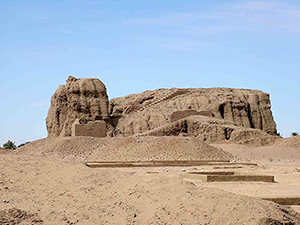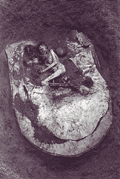BurialsKerma
The Kerma kingdom flourished in the city of Kerma— in the modern-day city of Kareema, in Sudan— starting from 2500 BC the latest. The city's population were organized into a hierarchically organized socio-economic strata. At the top of the hierarchy were the ruler, the royal family, military leaders, and priests. Although the site at Kerma has not been sufficiently excavated, American and European excavations, in collaboration with archeologists from the Khartoum University, came up with valuable results. The digs revealed an elaborate cemetery, a royal city, temples, royal palaces, and an audience hall. In a 1993-1994 campaign, Charles Bonnet uncovered the main town of Kerma with a fortification wall of 10 meters in height and 1300 meters in length.1
The people of Kerma people buried their dead in niche cut pits. A tumulus or a mound superstructure of sand and gravel, sometimes reaching 90 meters in diameter, was built over the graves of royal persons. The size of the mound indicated the social rank of the deceased person when alive. The larger the tumulus, the higher in rank the owner was; and the smaller it is, the lower in status. A distinctive element of the Kerma culture was the unique bed burial tradition. The distinctive design and manufacture of the Kerma bed didn't change over time; it represents the traditional Sudanese bed today and is called Angaraib. The deceased was placed on top of the bed. The bed was then placed in the middle of the tomb chamber. On some cases, mummification was conducted on deceased kings and royal persons. The body was usually laid in a contracted body position with the head towards the east. Flag staffs and square shaped steles were uncovered near tumuli structures and were probably related to the building structures. Pottery is perhaps the most common find in Kerma. Large amounts of imported pottery from Egypt and the Near East and seashells brought from the Red Sea indicate extensive trade activity. Weapons dating to this period were usually consisted of bronze swords and daggers, some of which were found in children graves. Most astonishing were the archer burials in Kerma in which individuals were buried with bows and arrows next to their bodies. Other goods included sandals, leather caps, ostrich feathers, and loincloths and cotton kilts. Large numbers of sacrificed humans and animals were found in royal graves. In 1923 George Reisner, the first archeologist to excavate at Kerma, uncovered a tumulus containing sacrificed human bodies.2 The scarified bodies were placed in opened roof mud brick corridors that ran along the middle of the tumuli structures before the latter were filled with earth. The sacrificed individuals are likely to have been servants and/or slaves to the burials' original owners. The Kushites believed in an afterlife, where the gods would sometimes require the deceased to do hard labor. Thus, sacrificing servants and slaves was considered a way for helping the deceased do this hard labor.
Edited: Jan. 2009. |


